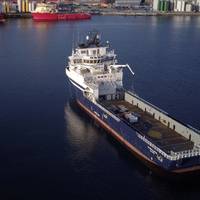Are OSVs Fit for Refit for Offshore Wind?

While it is generally agreed that the nascent offshore wind energy market in the U.S. will be a newbuild market, there is a repair and conversion possibility for some stacked OSVs.Though estimates on the pace of the offshore wind energy market in the U.S. vary widely, the direction is clear: offshore wind will be a huge marketplace for construction and support vessels to be deployed in U.S. waters over the next decade. The starting point for estimated vessel demand is the raft of projects along the U.S. East Coast, and to a lesser extent, in the Pacific waters, now in the pipeline.
Liftboat SUDA 300-L4T Delivered
A. K. Suda (SUDA) has successfully completed the design of a 300 ft. (91.5m) truss-legged liftboat. This vessel is being delivered to its owners in 1st Quarter 2016. This vessel follows on the heels of the world’s largest pipelegged liftboat, the SUDA 335-L3, delivered last year. This state-of-the-art vessel is a 4-legged, selfpropelled, self-elevating, general service liftboat, known as the SUDA 300-L4T. It is ABS classed with Unrestricted Service, A-1, AMS. The hull dimensions are 164 ft. x 98 ft., 5 in x 14 ft., 9 in, (50m x 30m x 4.5m). It has one leg encircling crane of 200T, and a 70T pedestal crane. The quarters arrangement can accommodate 85 persons including crew. It has a cargo deck area of 740 m2 of which 450 m2 is rated for 10 t/m2 and the balance for 5 t/m2.
Cat Power For Unique Boat
One of the most talked about crew/supply boats this year is a new 160 x 32-ft. (48.7 x 9.7-m) vessel designed by A. K. Suda, Inc. and built in Bayou La Batre, Ala. An innovative design, the vessel has no deep tonnage frames or tonnage openings and yet is certified by the Coast Guard as under 100 grt. Deep tonnage frames have long been used by boat designers as a way of excluding areas in the hull from inclusion in the 100 grt measurement — tonnage openings on the vessel's main deck are used in the same way. The vessel has no watertight boundary between the engine room and the passenger seating forward and yet meets or exceeds USCG stability standards. There is no need for a watertight bulkhead on the main deck to get from one personnel area to another.





